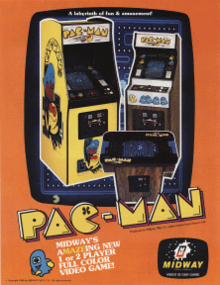
Back ፓክ-ማን Amharic Pac-Man AN باك مان Arabic باك مان ARZ Pac-Man AST Pac-Man Azerbaijani Pac-Man BE-X-OLD Pac-Man Bulgarian ཕ་ཁི་སི་ཐན་གྱི་མི། Tibetan Pac-Man Breton
| Pac-Man | |
|---|---|
 North American arcade flyer | |
| Developer(s) | Namco |
| Publisher(s) | |
| Designer(s) | Toru Iwatani |
| Programmer(s) | Shigeo Funaki Shigeichi Ishimura |
| Artist(s) | Hiroshi Ono[4] |
| Composer(s) | Shigeichi Ishimura Toshio Kai |
| Series | Pac-Man |
| Platform(s) | |
| Release | |
| Genre(s) | Maze |
| Mode(s) | Single-player, multiplayer |
Pac-Man, originally called Puck Man[a] in Japan, is a 1980 maze video game developed and published by Namco for arcades. In North America, the game was released by Midway Manufacturing as part of its licensing agreement with Namco America. The player controls Pac-Man, who must eat all the dots inside an enclosed maze while avoiding four colored ghosts. Eating large flashing dots called "Power Pellets" causes the ghosts to temporarily turn blue, allowing Pac-Man to eat them for bonus points.
Game development began in early 1979, led by Toru Iwatani with a nine-man team. Iwatani wanted to create a game that could appeal to women as well as men, because most video games of the time had themes that appealed to masculine interests like war or sports.[5][6] Although the inspiration for the Pac-Man character was the image of a pizza with a slice removed, Iwatani has said he rounded out the Japanese character for mouth, kuchi (Japanese: 口). The in-game characters were made to be cute and colorful to appeal to younger players. The original Japanese title of Puck Man was derived from the Japanese phrase paku paku taberu, which refers to gobbling something up; the title was changed to Pac-Man for the North American release due to fears of vandals turning the P into an F (as in fuck).[6]
Pac-Man was a widespread critical and commercial success, leading to several sequels, merchandise, and two television series, as well as a hit single, "Pac-Man Fever", by Buckner & Garcia. The character of Pac-Man has become the official mascot of Namco and later Bandai Namco Entertainment.[7] The game remains one of the highest-grossing and best-selling games, generating more than $14 billion in revenue (as of 2016[update]) and 43 million units in sales combined, and has an enduring commercial and cultural legacy, commonly listed as one of the greatest video games of all time.
- ^ "Pac-Man Official Website – History". Pac-Man Official Website. Retrieved April 26, 2022.
- ^ "Video Game Flyers: Pac-Man, Midway Manufacturing Co. (France)". The Arcade Flyer Archive. Retrieved April 8, 2021.
- ^ "Video Game Flyers: Puck Man, Namco (Germany)". The Arcade Flyer Archive. Retrieved April 8, 2021.
- ^ Kiya, Andrew (October 17, 2021). "Former Namco Pixel Artist Hiroshi 'Mr. Dotman' Ono Has Died". Siliconera. Retrieved October 17, 2021.
- ^ Lammers 1986, p. 265.
- ^ a b Prisco, Jacopo (May 21, 2020). "Pac-Man at 40: The eating icon that changed gaming history". cnn.com. CNN. Retrieved January 23, 2023.
- ^ "Pacman: The Phenomenon - Part 1 - Classic Gaming". October 16, 2007. Archived from the original on October 16, 2007. Retrieved February 19, 2023.
Cite error: There are <ref group=lower-alpha> tags or {{efn}} templates on this page, but the references will not show without a {{reflist|group=lower-alpha}} template or {{notelist}} template (see the help page).